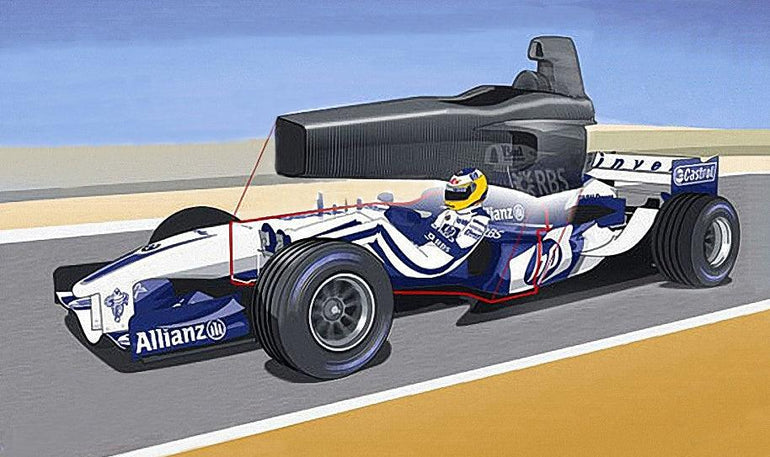[Guide] F1 is the sacred place in every man's heart. There are countless legends, flowers, champagne, and most importantly, the fastest car in the world. Whether it is body or power, these F1 cars are very different from ordinary civilian cars...
F1 is the sacred place in every man's heart. There are countless legends, flowers and champagne, and most importantly, the fastest car in the world.

Whether it is body or power, these F1 cars are very different from ordinary civilian cars. Today we are going to talk about the unique carbon fiber body of F1 cars and the possibility of using this material in civilian cars in the future.

Carbon fiber monocoque history
Monocoque technology has a long history. As early as 1923, at the French GP, Louis Blério, known as the pioneer of aeronautical engineering and automobile design and manufacturing, released a car with a monocoque structure designed by him. But it wasn't until 1962 that the Lotus 25 car showed its advantages of light weight and high strength for the first time. The technician’s approach is to replace the traditional tubular frame cockpit with a light metal shell reinforced with rivets. This is also the first monocoque introduced into the F1 arena. In the following year, Jimmy Clark drove the Lotus 25 to victory in seven races and finally won the annual championship.
Interestingly, according to data records, Colin Chapman, the founder of Lotus Motors, and Mike Costing, who was responsible for the design of the Lotus Racing chassis at the time, described the original monocoque body concept in a napkin. Greatness happened on a napkin!

As for the use of carbon fiber materials in F1 cars, that is another legend-the 1981 Formula One McLaren MP4/1.
Although the material has been used in small components many times before, MP4/1 is the first racing car that truly applies carbon fiber composite material to the entire chassis design. By increasing the load on the chain shaft of the related materials, the stiffness-to-weight ratio of the carbon fiber composite racing car is greatly improved, which makes the racing car lighter, faster and safer. After that, the material that made the car lighter, faster and safer never left the F1 arena.

Interestingly, due to its excellent performance in F1, this material has been valued by relevant American agencies. They hope to use this material as a covering material on the bottom of the gunship fuselage to withstand ground fire attacks. A good story.
What is the principle of carbon fiber monocoque?
For the explanation of the principle of carbon fiber monocoque, there is a more vivid explanation, that is, egg shell. According to data records, when the egg is evenly stressed, one egg can withstand nearly 30Kg of force, while one egg is about 60g. In 1989, Kasugai, a citizen of Aichi Prefecture, Japan, used 34 eggs on the front wheels of a car and 52 eggs on the rear wheels to support a large truck.

Why can an eggshell carry a weight much greater than its own weight? In fact, the eggshell is a porous solid with a sandwich structure, which has the characteristics of high specific strength, specific rigidity and overall lightweight. As a thin shell structure, under the action of external force, the force can be evenly transmitted to the surroundings along the entire shell surface. There is no case where the force is concentrated in a certain place on the shell, and the force per unit area is not Big.
In fact, the monocoque technology is a bionic application of the eggshell principle. It is different from the traditional car body using the internal frame structure to carry the load, but carries the load through the shell surface, and other parts on the car body are directly connected with the monocoque. The advantage of this is that the weight of the car body is greatly reduced, and the force of the load bearing is evenly distributed to each surface, which obtains the torsional rigidity that cannot be matched by the traditional load-bearing structure.

In addition, because carbon fiber is a new material with excellent mechanical properties, its specific gravity is less than 1/4 of that of steel, its tensile strength is generally above 3500Mpa, which is 7-9 times that of steel, and its tensile modulus of elasticity is 23000-43000Mpa Also higher than steel. This further strengthens the excellent performance brought about by this structure.
Possibility of civilian use
At present, there are not many carbon fiber material structures used in civilian cars. Most of them are concentrated on some sports cars, and most sports cars follow the traditional layout of F1 racing cars. The carbon fiber monocoque exists as a load-bearing structure and connecting parts. But this is only a toy for the rich after all. Cars with a carbon fiber monocoque structure are often very expensive. For example, McLaren 570S Coupe, Ferrari-LaFerrari, etc. all use this structure.

Everyone has a negative attitude towards the use of this material because of its high cost, difficult process, high maintenance cost, and low service life. In the final analysis, it is a cost issue. How to reduce costs is the key to this technology's move to civilian vehicles.
With the increasing attention to carbon fiber materials at home and abroad in recent years, this technology has received a lot of policy and financial dividends, and its development speed is quite fast. Taking China as an example, many companies have made breakthroughs in T300 carbon fiber and have certain industrialized production capabilities. The global carbon fiber market was only US$900 million in 2005, and reached US$10 billion in 2013. It is expected to reach US$40 billion by 2022. The application of carbon fiber composite materials will also enter a new era.
It can be seen that the development momentum of this material is very fierce, and the input often determines the result. In addition, the barriers to raw material processing are not large, so reducing the cost of raw materials is not infeasible.

The problem of raw material cost is solved, and then the problem of processing cost. Different from the traditional weaving molding process, pultrusion process, filament winding molding process, etc., many new molding methods have emerged. For example, some companies have adopted the thermoplastic carbon fiber process to form the engine cover as a whole. It greatly improves the strength and precision of the product, solves the problem of mass production of automotive carbon fiber parts, and reduces the overall cost by about 30% compared to magnesium aluminum alloy.
Having said that, most of them are some prospective proofs. We can take a look at the cheap models that have appeared now. For example, the domestic model Yidai T300, as a three-wheeled electric sports car, uses a monocoque body made of composite materials, and the price of the whole car is less than 120,000 yuan.
From the appearance, although it does not use carbon fiber materials, the body adopts a monocoque structure. It can be seen that the monocoque structure can be applied to ordinary civilian vehicles. Now, the material problem needs to be solved urgently, especially Carbon fiber materials, but the history is often similar, as if the first monocoque used in F1 racing cars was made of aluminum. Perhaps in the near future, carbon fiber materials can be used in cheap cars.








